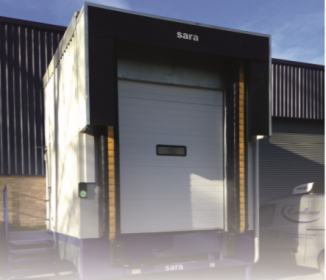Modular docks - opening up possibilities
Published: 05 September, 2019
Efficient loading bays can be built in less than ideal locations if the needs of the operating processes are properly analysed and the full range of equipment is explored. Kevan Anderson, an area sales manager with sara LBS, is motivated by a recent installation to review the possibilities opened up with modular docks.
A client was expanding its production centre and asked if I had a solution to a problem that had flummoxed its architect. It wanted to expand its production floor into what had been the goods inwards and goods outwards loading bays, but did not think it had space anywhere on the site for new loading bays. On top of this space issue there was a standing requirement to maintain hygiene barriers between the outside environment and the super-clean interior of the building.
I drove over to meet them armed with a pencil, sketchpad and a sneaking suspicion that I already knew the answer. In fact, this problem is not as rare as the client thought; I have addressed it several times in the past. The solution lies in some standard sara LBS products – modular docks, which are also known as both dock loading pods and as loading houses.
These are essentially external loading dock enclosures which can be installed directly onto the face of a building. sara LBS usually constructs these out industry standard prefabricated building panels, but in truth any almost construction technology could be used.
In most retrofit installations they are positioned so that one end is co-incident with and encompasses the existing loading bay door and they project out over what had been the parking apron of the old internal loading bay. However, they can be positioned so that they are half in and half out of the loading bay, or indeed some distance from the original loading bay. Whatever the layout, the vehicle backs up to the end of the pod so that there is direct access for efficient loading.
Usually the pod contains a scissor lift, ramp or dock leveller, which is used to address the difference in height between ground level and the floor of the truck (which for most heavy goods vehicles is a standard 1.2m).
Typically the pod will have a door at one or both ends, which can be used to keep heated, treated, filtered or cooled air within the building and to keep out chilling winds. The door(s) also function as a barrier against birds, vermin and microbes. The door at the interior ends can be a high speed roller shutter, curtain door or otherandard option. Typically the pod will be sealed to the building around the outer edges of this door’s frame.
The designer has to remember that the rear end of the truck will be parked up close to the exterior of door at the other end of the pod, so a fully supportive strong and stable steel frame may be a good idea. A canopy, curtain, foam or inflatable seal may also be required, especially if hygiene or air exchange are issues for the particular installation. Further the canopy can be thermally insulated to maximise energy efficiency.
Importantly, if there are doors at both ends these can be electronically interlocked so that only one can open at a time, thus maximising pest control and minimising energy loss. Alarms, timers, double locks and other automated options can also be fitted.
Summing up the concept of dock loading pods, we can say: they provide an effective solution to many real world problems, yet are easy to build and often the most budget friendly option. If fitted with dock seals the gaps between the pod and the vehicles are largelyeliminated, thus providing hygiene protection and reducing loss of heated or treated air. Flexibility in the design of the pods allows for a range of door positions and types, plus the installation of other equipment such as traffic lights, hydraulically operated dock levellers, insulated roof and side panels, integrated controls for all electrical equipment, wheel guides, buffers, bollards and internal lights.
While in this case my client installed dock loading pods as a cost-effective way to allow expansion of the production department, pods are also particularly suited to industrial, warehouse and storage applications where temperature control or hygiene is important as they can provide an air lock function. They are also useful where space is restricted, if access constraints require lorries to park at an angle to the building, and where budgets constraints mean a conventional extension to a building is not an option.
Finally, one of the nice outcomes of the recent project was that the architect admitted that his initial misgiving had been unfounded and that the new pods actually enhanced the appearance of the building, lending it an air of modernity and industrial effeciency.







